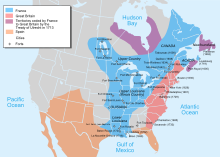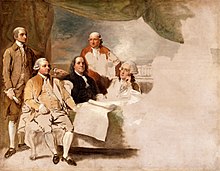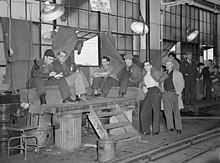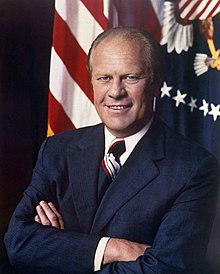History of Michigan
In 1701, the French officer Antoine de la Mothe Cadillac, along with fifty-one additional French-Canadians, founded a settlement called Fort Pontchartrain du Détroit, now the city of Detroit.
After the British were defeated in the American Revolutionary War, the Treaty of Paris (1783) expanded the United States' boundaries to include nearly all land east of the Mississippi River and south of Canada.
The opening of the Erie Canal in 1825 connected the Great Lakes with the Hudson River and New York City, and brought large numbers of people to Michigan and provided an inexpensive way to ship crops to market.
In 1835 the people approved the Constitution of 1835, thereby forming a state government, although Congressional recognition was delayed pending resolution of a boundary dispute with Ohio known as the Toledo War.
[citation needed] Given the fact that they are culturally related & the Mascouten disappear from maps of the region around the same time that the new name appears, they may have later become known as the Wea, or Wabash tribe.
Together with their native allies, they chased the Iroquois out of the region by 1701, forcing them to sign a treaty recognizing the Niagara River & the Ohio-Pennsylvania borders as the ends of their lands.
Rumor also has it that a group of Piscataway (an Algonquian tribe from Maryland) called the Conoy migrated into West Virginia & were noted as living around modern-day Detroit by 1819.
Since Anishinaabe was a collective term for the Ojibwe, Odawa & Potowatomi/ Nishnabe, who formed a governed confederacy known as the Three Council Fires,[22] most of the Algonquian peoples around Lake Superior referred to their lands as 'something Anishinaabaki.'
Although the Anishinaabeg (plural) did not have a true, organized government (they would usually elect temporary leaders called Ogidamoo in the moment[23] ), the sacred site of their council fire, where they would conduct important political business, was known as Michilimackinac.
[24][25] The first European explorer to visit Michigan was the Frenchman Étienne Brûlé in 1620, who began his expedition from Quebec City on the orders of Samuel de Champlain and traveled as far as the Upper Peninsula.
During this period Detroit grew slowly; the rest of Michigan continued to be sparsely populated because the French were more interested in the fur trade and peace with the natives than in settlement of the area.
[32] General Anthony Wayne with his Kentucky marksmen won the Battle of Fallen Timbers which led to the end of hostilities and treaties recognizing federal government sovereignty.
During the War of 1812, British forces from Canada captured Detroit and Fort Mackinac early on, giving them a strategic advantage and encouraging native revolt against the United States.
The disputed zone became part of Ohio by the order of a revised bill passed by the U.S. Congress and signed into law by President Andrew Jackson which also gave compensation to Michigan in the form of control of the Upper Peninsula.
It comprised numerous competing factions, including the federal officeholders who tried to control party affairs, local political organizations with their state legislators and postmasters who managed affairs locally; young anti-slavery activists, typically energized by pietistic ministers in the Baptist and Methodist churches—they fueled the Free Soil Party in 1848–52; Jacksonian Democrats who opposed taxes and government spending; Catholics, Episcopalians and liturgical Germans annoyed at the moralistic pietists; and residents in the newer western districts who resented the elitism and power of Detroiters.
[47] The First Michigan Infantry Regiment was formed from militia from cities including Adrian, Ann Arbor, Burr Oak, Coldwater, Detroit, Jackson, Manchester, Marshall and Ypsilanti.
[48] A study of the cities of Grand Rapids and Niles shows an overwhelming surge of nationalism in 1861, whipping up enthusiasm for the war in all segments of society, and all political, religious, ethnic, and occupational groups.
While some coastal settlements had previously existed supplied by sailing ships and steamers on the Great Lakes, the population, commercial, and industrial growth of the state further bloomed with the establishment of the railroad.
The breakfast cereal industry was based in Battle Creek where two Kelloggs and a Post built on the local Seventh-day Adventist heritage and put the city on the map.
Both corporations constructed large industrial complexes in the Detroit metropolitan area, exemplified by the River Rouge Plant, which have made Michigan a national leader in manufacturing since the 1910s.
Including: Reeves, Jaxon, Jackson, CarterCar, Orlo, Whiting, Butcher and Gage, Buick, Janney, Globe, Steel Swallow, C.V.I., Imperial, Ames-Dean, Cutting, Standard Electric, Duck, Briscoe, Argo, Hollier, Hackett, Marion-Handly, Gem, Earl, Wolverine, and Kaiser-Darrin.
He is remembered as the most dynamic and innovative mayor in the city's history, as well as a powerful political boss who built a coalition of working-class ethnic voters, combined with middle-class reform elements.
With the discovery of copper finds in other states located in less deep rock layers, local mining fell sharply and most miners left the region or resigned themselves to short hours and long unemployment.
Strikers occupied several General Motors plants for more than forty days, and repelled (in nonviolent fashion) the efforts of the state courts, local police and National Guard to remove them.
[61] Starting during World War I, the Great Migration fueled the movement of hundreds of thousands of African-Americans from the South to industrial jobs in Michigan especially in Detroit.
The postwar years were initially a prosperous time for industrial workers, who achieved middle-class livelihoods, fostered the Baby Boom, and sought better, more spacious housing in safer neighborhoods.
In 1967 there was a major riot in Detroit that burned out the inner city, caused tens of millions of dollars in damages, and resulted in 43 deaths with the U.S. Army being called in to stop it.
Increasing competition by Japanese and South Korean auto companies continues to challenge the state economy, which depends heavily on the automobile industry.
The Federation pressured Detroit officials to upgrade schools, water supplies and sanitation facilities, and to require safe food handling, and traffic safety.
However, the membership was divided on going beyond these issues or collaborating with ethnic or groups or labor unions; it refused to stretch traditional gender boundaries, giving it a conservative reputation.











